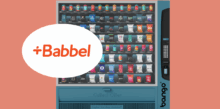Breaking down subscription bundling complexity: a technical guide
by Cei Sanderson | 22 May 2025
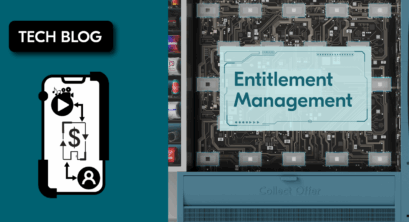
Subscription bundling can rapidly become complicated, especially when managing interactions between multiple parties, services, and billing plans. Every integration, every entitlement, and every consumer interaction brings complexity. That’s why orchestrating subscription bundling at scale requires more than simply connecting APIs to manage entitlements – it demands efficient orchestration that handles the end-to-end subscription bundling, the entitlement and the billing.
For services like mobile telephony or home broadband – additionally offering consumers access to all their favorite content on a single monthly bill can be transformative. It’s called subscription bundling: the practice of integrating multiple services from partners and presenting them as a singular experience with unified billing, boosting customer acquisition and retention and driving revenue growth. Some examples:
- A mobile operator offering subscriptions to streaming services like Netflix or HBO Max, billed on their data plan.
- A broadband provider offering discounts to online gaming platforms along with their monthly internet service.
- A retail chain offering loyalty points for adding entertainment services when consumers open an account.
The Digital Vending Machine® (DVM) from Bango is designed precisely to solve these integration headaches by acting as a centralized orchestration layer between Resellers, Content Providers, and Consumers. Let’s dive into how DVM achieves this, simplifying complexity and managing subscriptions at scale.
Key Roles in Subscription Bundling
For subscription bundling, there are 3 roles involved:
- The Reseller – the party bundling the products/services together into consumer offers (e.g. Telcos).
- The Content Provider – the party providing the products or services to be bundled (e.g. Netflix, Max, Peloton, Babbel).
- The Consumer – the end user subscribing to the bundled offers.
It’s important to note these roles can overlap – for instance, a Telco might act both as a Reseller and a Content Provider.
Understanding subscription bundling – Core Concepts: Entitlements, Offers, and Billing Plans
Central to subscription bundling within the DVM is the concept of Entitlements. An entitlement defines and manages a consumer’s right to access a specific product or service tier. Entitlements can be created, updated, suspended, resumed, or revoked.
To effectively manage entitlements, DVM uses three supporting concepts:
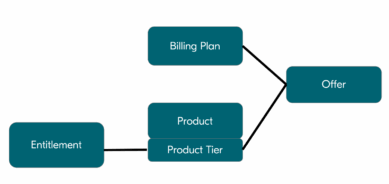
- Products and Product Tiers: Different levels or variants of a service (e.g., Netflix Basic, Standard, Premium).
- Billing Plans: How and when consumers are billed (e.g., free trials, monthly subscriptions).
- Offers: A consumer-facing bundle combining products/product tiers with billing plans.
For instance, consider an offer: “6 months free of Disney+ Standard with Ads.” Here:
- Product Tier: Disney+ Standard with Ads
- Billing Plan: Free for 6 months, then monthly payment
- Taking the offer grants the consumer an Entitlement to access this specific product tier.
The Bango DVM simplifies orchestration and integration
With consumers enjoying multiple subscriptions and bundles, the average US subscriber now pays for 5.4 subscriptions, with 2 of those acquired through bundles or third-party channels (Subscriptions Assemble 2025), with different content providers, each with different expiry dates, eligibility rules, offer conditions, the technical complexities of managing these factors across systems is a major cost if you’re planning on building it yourself.
The Digital Vending Machine from Bango acts as an intermediary. In acting as an intermediary, Bango exists as an ecosystem. It abstracts away the complexity of one party needing to understand the other’s APIs and Parties onboard to DVM irrespective of their subscription bundling channel partners. The DVM relies on two primary interfaces:
- The Reseller API is used by Resellers and DVM to interact for tasks like offer creation, billing arrangements, status checking, and lifecycle management.
- Content Provider APIs are endpoints used by Content Provider and DVM to communicate with service provider processes such as Netflix’s sign-up. Customers like telcos don’t access these directly – they deal with process tasks like activation redirects.
Comprehensive Offer Management
Beyond just API integrations, DVM manages the full lifecycle of bundled subscriptions. Resellers can:
- Quickly define new offers, combining multiple services and billing conditions as well as offer conditions such as trial durations and renewal frequencies. (Read DVM CX Blog)
- Centrally control the activation, renewal, upgrades, pauses, or cancellations of subscriptions.
- Manage and maintain an accessible consumer experience to meet Content Provider and Consumer expectations.
These capabilities simplifies the otherwise intricate management of bundled products across various scenarios, including new user onboarding, account upgrades, or migrating customers between offers.
Data Governance and Compliance
Ensuring data governance compliance, especially around personal identifiable information (PII) regulations like GDPR, is critical. DVM addresses this by:
- Using Reseller-specific identifiers (ConsumerIdentifier) kept private within the Reseller and DVM.
- Creating a shared identifier (SharedCustomerId) for consistent data management across all partners, facilitating smooth operations without compromising consumer privacy.
Orchestrating the Consumer Activation Workflow
Let’s look at a typical scenario: a consumer subscribes to a “Premium Mobile package + Netflix and Max bundle.”
Step-by-step orchestration in DVM:
- Reseller triggers creation of entitlements via DVM Consumer Offer API.
- Eligibility checks ensure the consumer qualifies (e.g., first-time user, account status).
- Consumer identifiers (ConsumerIdentifier and SharedCustomerId) are generated for data governance and compliance (GDPR, etc.).
- Entitlements for each service (e.g., Netflix and Max) are created and sent to respective Content Providers.
- Billing plan lifecycle is initiated, managing trial periods and subsequent billing.
- Activation URLs are generated and returned to the Reseller, who then directs the consumer to activate services.
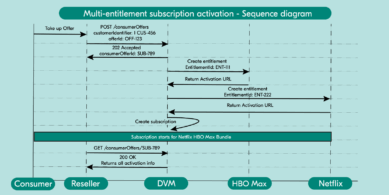
This seamless orchestration eliminates manual integrations, ensures compliance, and delivers a smooth consumer experience.
Real-world example
Consider consumer, CUS-456, signing up for a typical offer, OFF-123. The offer is “Premium Mobile package + Netflix and Max bundle”.
Offer Defined:
- Eligibility: Premium Mobile Package
- Product Tiers: Netflix Standard and Max Standard
- Billing: First month free, then bundle monthly subscription
Customer acquisition flow
- Reseller requests entitlements via DVMs API.
Method: POST
Endpoint: /consumerOffers/
Request Body
{
“consumer”: {
“ConsumerIdentifier”: ” CUS-456″
},
“offer”: {
“offerId”: ” OFF-123″
}
}
The offerID is a DVM UUID identifier, generated when the offer was created.
That request triggers an automated orchestration of DVM services:
- An eligibility check for the product – the Premium Mobile package and logic such as previously used free trials.
- A creation of the consumer identity in DVM based upon the consumerIdentifier and generating that sharedCustomerId.
- Creation of the entitlements, 1 to each of the product tiers in the defined offer .
- That entitlement creation is sent to the Content Providers along with the ProductSKU (the identifier the Content Provider has for their product)
- Creation of the billing plan lifecycle for the offer, as defined in the offer1.
- DVM generates an activationUrl for the streaming service and returns it to the Reseller.
Redirects and Timeouts are handled as part of the process, ensuring compatibility across devices and front-end software like browsers while staying compliant with regional restrictions on content.
[1] This create entitlement is also a public API endpoint /v1/entitlement which can be used to directly create an entitlement without orchestration, perfect for testing out the DVM APIs.
That flow can be summarized visually in the following sequence diagram
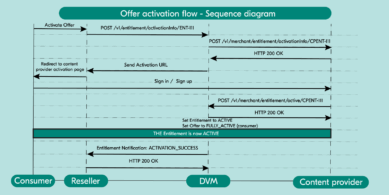
Consumer Activation flow
The entitlement and the billing plan subscription have been created. The Reseller has a redirect URL to provide to the Consumer so they can activate and get going. Perhaps the Consumer took up the offer in the morning, but didn’t get a chance to activate their entitlement to Max and Netflix. Many content providers expire their redirect URLs to reduce fraud risk. The activation flow therefore starts with a refresh of the activation URL.
- The Reseller requests a new activation URL, which DVM passes on the request to the Content Provider to generate.
- The reseller uses the new activation URL to send to the Consumer, either a redirect if coming from a subscription hub, via email, SMS or whatever the communication channel might be.
- The Consumer is taken to the Content Provider site, where they sign in (or sign up if it’s a new account).
- The Content Provider will then return the activation result, so that DVM and the Reseller all understand that the Consumer has activated.
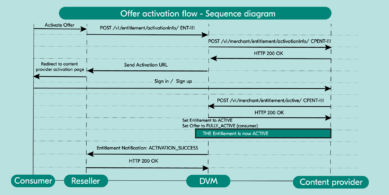
Even once active, there are many in life actions that can occur on the entitlement or the plan. The consumer could pause their subscription, they could upgrade the product, or even cancel. Even further, the consumer could upgrade the product during activation, or the Content Provider could roll out a price change impacting new consumers and existing alike. DVM handles all of these, and more scenarios, using similarly usable endpoints. For example, if the consumer actions an upgrade (such as a user switching from “Max with Ads” to “Max Premium”) then PATCH /v1/entitlement triggers an entitlement update and a plan update. Much more to come on this in future blogs.
Scalability and supporting the evolving subscription economy
Subscriptions business models, DVM isn’t only about solving today’s challenges—it’s built for scalability. It can quickly accommodate new products, evolving regulatory compliance, or changing billing requirements, providing Resellers with a future-proof subscription management solution.
Conclusion
The Digital Vending Machine from Bango is more than a connectivity or entitlement management tool – it’s a comprehensive orchestration product that simplifies complicated subscription bundling. By centralizing API integrations, entitlement management, and billing lifecycle processes, DVM allows Resellers to seamlessly onboard new partners, manage subscription bundles, maintain compliance, and deliver an optimal consumer experience – all at scale.
Ultimately, DVM solves integration headaches, simplifies orchestration complexity, and positions your subscription bundling business for growth.
Stay tuned for future blogs, where we’ll explore more technical scenarios, such as upgrades, pauses, the billing plan lifecycle, and more real-world examples of subscription bundling success powered by DVM.
Subscribe to our newsletter
Get the latest subscription bundling news and insights delivered straight to your inbox.



